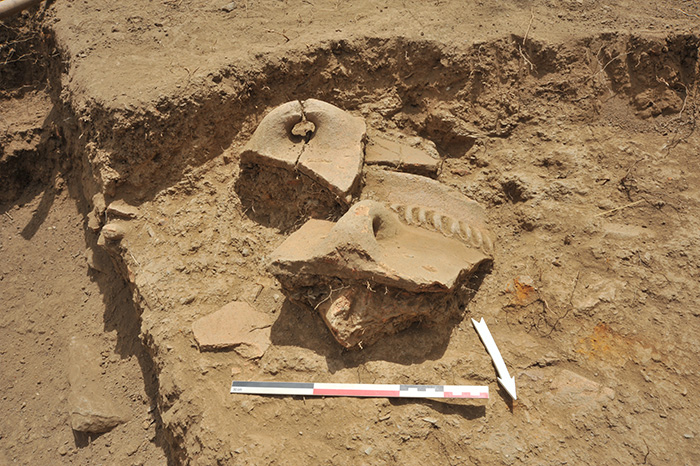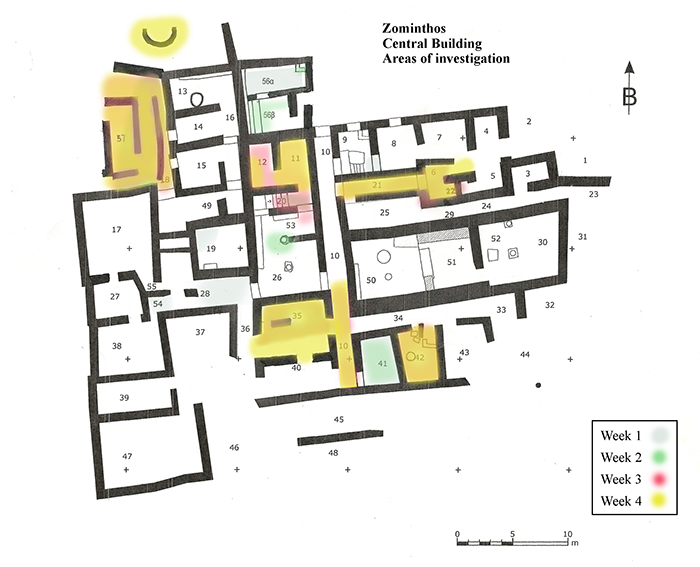August 4, 2014


During the fourth week of excavation at the southern part of Corridor 10 it has almost reached the floor level and gradually advances towards the already excavated part of the corridor.
Two paved doorsteps were uncovered, one in the southeast and another in the southwest, that lead to two rooms. On the doorsteps, the circular door sockets remain intact (fig.1).
The collected pottery of high quality includes some pot shapes found for the first time in Zominthos (fig.2).
At Corridor 18 layers 4 to 7 were removed along with some big stones (with the biggest one reaching a size of 45x36x18cm). A few pottery sherds were collected, most characteristic of which were the feet of some cooking pots and parts from conical cups. Traces of fire were also detected, some pieces of carbon were collected and some stone slabs came to light. With the 7th Layer the excavation of the Corridor came to an end and it was observed that the western wall leans towards its interior (fig.1).
At the area to the west of Corridor 18, the removal of the first Layer of debris was completed. It produced a large amount of pottery sherds, among which parts of big pithoid vessels, and a lot of animal bones. During the excavations four walls were revealed (fig.2) and it was decided to give to the area the name “Room 57”. A lot of pottery was collected as well as animal bones. Among the finds were the handles and big parts of a pithos (fig.3).
In the area north of Corridor 18 and Room 57 the second Layer was removed and some pottery was unearthed, mostly conical cups.
At Room 6 the research this week expanded towards the East. This new part is named 6b. 4 layers were removed from its interior bringing it to the same level as Room 6a and uniting it with the rest of the room (fig.1). Pottery sherds were found, very few bones and a large amount of plaster fragments with red surface. Some restoration works also took place in the western part of the southern wall.
At Corridor 21 two layers were removed. Pottery sherds; a few bones, very few pieces of carbon and a large number of plaster fragments with red or ivory surface were collected. The threshold of the eastern edge of the Corridor was revealed (fig.2) as well as the paved floor consisting of 9 rectangular stones (fig.3).
At Room 22 one more layer was excavated and some pottery sherds and plaster fragments were unearthed.
At Room 11 Layers 2 and 3 were removed (fig.1). With that, only one layer remains to be cleared over the floor of the Room. In the three corners amongst a lot of carbon pieces, pots from the floor layer, mostly conical cups (fig.2), are already visible.
At the neighboring Room 12 some stone slabs were removed from the western part, which were left in situ when the excavation of the Room was completed in 1990 and the paved floor was revealed (fig.3). From the southwest corner, four conical cups came to light (fig.4).
A few meters in the north of the ceramic workshop (Room 13) of the Central Building of Zominthos a circular clay construction was partially unearthed during the excavation of 1990. This structure forms most probably a part of the pottery kiln of the workshop (fig.1). During this week the excavation continued to the West, where the kiln seams to expand towards a west/northwest direction (fig.2).
[ngg src=”galleries” ids=”172″ display=”basic_slideshow”]For the fourth week the investigation carried on at Rooms 35a and 35b (fig.1), in the south/southwest part of the Central Building.
Inside Room 35a two more layers were excavated, where big concentrations of fallen stones were found, and at the same time the southern wall was uncovered for the most part under the roots of a big tree (fig.2). The southern wall, which was revealed during this year’s investigation, divides Rooms 35a and 40. In the area of the eastern opening to Corridor 10 more clay-earth came to the surface and two burned parts of wooden poles fallen from the upper floor were uncovered. A bronze dagger (fig.3), a bone pin (fig.4), two small grinding stones, parts of conical cups and bone parts from big-size animals were included in the finds.
At Room 35b two more layers were removed. A lot of clay earth and lepidha-earth came to light, that originated from structural elements of the upper floor, and big piles of stones were removed. Lastly, the middle wall which divides the two rooms was uncovered fully in the western part of Room 35b and the possibility of a small opening between Rooms 35a and 35b in this spot is under further investigation.
The excavation of Room 42 continued this week. Many pottery sherds were collected, animal bones and a few small-size pots (fig.1). Also, burned soil was detected in some parts of the Room. The most special finds were a bone pin and a part of a pot, probably a tray (fig.2). The northern wall of the Room has two openings devided by a pillar. South of this pillar a stone structure was revealed in the northeast corner of the Room (fig.3).
[ngg src=”galleries” ids=”174″ display=”basic_slideshow”]